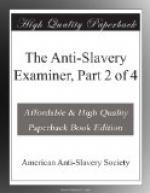From Millar’s we proceeded to Fitch’s Creek Estate, where we had been invited to dine by the intelligent manager, Mr. H. Armstrong. We three met several Wesleyan missionaries. Mr. A. is himself a local preacher in the Wesleyan connection. When a stranger visits an estate in the West Indies, almost the first thing is an offer from the manager to accompany him through the sugar works. Mr. A. conducted us first to a new boiling house, which he was building after a plan of his own devising. The house is of brick, on a very extensive scale. It has been built entirely by negroes—chiefly those belonging to the estate who were emancipated in 1834. Fitch’s Creek Estate is one of the largest on the Island, consisting of 500 acres, of which 300 are under cultivation. The number of people employed and living on the property is 260. This estate indicates any thing else than an apprehension of approaching ruin. It presents the appearance, far more, of a resurrection, from the grave. In addition to his improved sugar and boiling establishment, he has projected a plan for a new village, (as the collection of negro houses is called,) and has already selected the ground and begun to build. The houses are to be larger than those at present in use, they are to be built of stone instead of mud and sticks, and to be neatly roofed. Instead of being huddled together in a bye place, as has mostly been the case, they are to be built on an elevated site, and ranged at regular intervals around three sides of a large square, in the centre of which a building for a chapel and school house is to be erected. Each house is to have a garden. This and similar improvements are now in progress, with the view of adding to the comforts of the laborers, and attaching them to the estate. It has become the interest of the planter to make it for the interest of the people to remain on his estate. This mutual interest is the only sure basis of prosperity on the one hand and of industry on the other.
The whole company heartily joined in assuring us that a knowledge of the actual working of abolition in Antigua, would be altogether favorable to the cause of freedom, and that the more thorough our knowledge of the facts in the case, the more perfect would be our confidence in the safety of IMMEDIATE emancipation.
Mr. A. said that the spirit of enterprise, before dormant, had been roused since emancipation, and planters were now beginning to inquire as to the best modes of cultivation, and to propose measures of general improvement. One of these measures was the establishing of free villages, in which the laborers might dwell by paying a small rent. When the adjacent planters needed help they could here find a supply for the occasion. This plan would relieve the laborers from some of that dependence which they must feel so long as they live on the estate and in the houses of the planters. Many advantages of such a system were specified. We allude to it here only as an illustration of that spirit of inquiry, which freedom has kindled in the minds of the planters.




